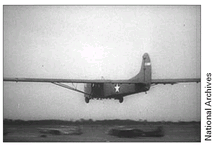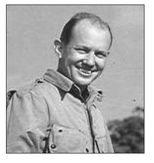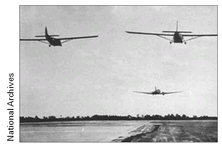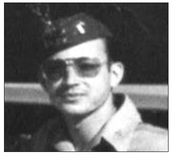War Stories II (30 page)
Authors: Oliver L. North
The daring plan, approved by Admiral Mountbatten, also solved Wingate's dilemma of how to evacuate the sick and wounded from deep behind enemy lines. American “air commandos” would bring in equipment
to cut landing strips in the jungle from which light aircraft could operate and fly out casualties to hospitals in China or India.
to cut landing strips in the jungle from which light aircraft could operate and fly out casualties to hospitals in China or India.
Such cooperation was relatively rare in the CBI theater. It was no secret that Chiang Kai-shek and the acerbic “Vinegar Joe” Stilwell all but hated each other. Nor did Stilwell make any pretense of getting along with Chennault. Nonetheless, after being pressured by General Hap Arnold in Washington, he gave his grudging approval to Mountbatten's plan. The concept of using gliders and light aircraft to support LRP operations was the brainchild of two brilliant young aviators, Lieutenant Colonels Phil Cochran and John Alison. Because heavy transport aircraft would never be able to take off from the rough-cut airstrips carved out of the jungle, Cochran and Alison proposed using American-built CG-4A Waco gliders to ferry men and matériel behind enemy lines. Thousands of the CG-4A gliders were being built for use in World War II. Designed for a one-way trip into combat, the plywood and fabric craft were inexpensive to construct, could be towed to the vicinity of their landing sites by conventional transports, and required only a clearing in which to land. But they also needed incredibly daring pilots and crews to fly missions in them.
Â
The Waco CG-4A glider

Cochran and Alison also convinced Hap Arnold that the air commandos would need an allocation of tiny, single-engine, Stinson L-5 aircraft to use as air ambulances. They had run some tests and confirmed that the little planes could carry one ambulatory patient and one litter patient from the bare-bones landing strips built by the air commandos.
General Arnold approved the Cochran-Alison air support plan and convinced Stilwell to go along with it. Alison recalled Arnold's admiration for Wingate: “This man walks into Burma, and it takes him six weeks to get into position to where he can really hurt the Japanese. When he gets there, his men are tired, many of them have malaria, and a lot of them are sick. Some of them are woundedâsome killed.” The plan Wingate's subordinates had
developed would move the irregular troops into place in just a few hours by air. Arnold then told the two young officers, “I don't want them to walk. I'm going to give you everything you need to do it. Now... which one of you is gonna go?”
developed would move the irregular troops into place in just a few hours by air. Arnold then told the two young officers, “I don't want them to walk. I'm going to give you everything you need to do it. Now... which one of you is gonna go?”
After briefly thinking about it, Arnold dispatched both Alison and Cochran as “co-commanders” to India to oversee the delivery of equipment, the assembly of the Waco gliders, and the training of the 523 American pilots and aircrews who volunteered to join the 1st Air Commandos. The two men were uniquely suited to the task.
Alison had already proven himself a skilled pilot, a gifted flight instructor, and a resourceful staff officer. He was already an ace, having shot down more than five enemy aircraft while flying with British and Russian pilots that he'd helped train.
Alison's close friend Lt. Colonel Phil Cochran was the epitome of the suave and daring fighter pilot. Milton Caniff, creator of the
Terry and the Pirates
comic strip, fashioned Terry's flight instructor after Cochran. He wasn't just a great fighter pilot; he was also a charismatic leader who instilled confidence in the men he led.
Terry and the Pirates
comic strip, fashioned Terry's flight instructor after Cochran. He wasn't just a great fighter pilot; he was also a charismatic leader who instilled confidence in the men he led.
Charles Turner served with Alison and Cochran as one of the Waco glider pilots in the 1st Air Commandos. Sergeant Raymond Bluthardt was an Army engineer who helped cut airstrips and build roads deep inside Burma during Operation Thursdayâthe largest unconventional warfare campaign in the CBI theater.

LIEUTENANT COLONEL JOHN ALISON, USAAF
Forward HQ 1st Air Commandos
Allied Expeditionary Air Base
250 Miles Inside Japanese-Controlled Burma
5 March 1944
Forward HQ 1st Air Commandos
Allied Expeditionary Air Base
250 Miles Inside Japanese-Controlled Burma
5 March 1944

Phil Cochran and I started out as co-commanders, but after about a month, it was so confusing I said, “Look, Phil, let's just go back and be
regular soldiers. You're the ranking officer; I'm your deputy, let's get this job done.” So then we considered what tools were available. We had the option of using either gliders or paratroopers. We used paratroopers as pathfinders to mark landing sites, but needed a way to take in an airborne engineer company, scrapers, and carry-alls. So we decided that we should use gliders, to get the troops and heavier equipment in so they could then make airfields for transports that could deliver the rest of the troops and their equipment. General Arnold gave us thirty P-51s, fifteen B-25s, thirty C-47s, a hundred L-5s to use as ambulance planes, and almost a hundred cargo gliders.
regular soldiers. You're the ranking officer; I'm your deputy, let's get this job done.” So then we considered what tools were available. We had the option of using either gliders or paratroopers. We used paratroopers as pathfinders to mark landing sites, but needed a way to take in an airborne engineer company, scrapers, and carry-alls. So we decided that we should use gliders, to get the troops and heavier equipment in so they could then make airfields for transports that could deliver the rest of the troops and their equipment. General Arnold gave us thirty P-51s, fifteen B-25s, thirty C-47s, a hundred L-5s to use as ambulance planes, and almost a hundred cargo gliders.
Â
C-47 towing two Waco gliders

Somebody suggested that we try snatching the glider's tether with a moving C-47. American Aviation of Wilmington, Delaware, had developed the technique for picking up mail sacks in the West Virginia mountains. They had devised a level-winding reel that had an automatic brake and you could adjust the tension. At the end of this line we put a loop of nylon rope that had a catch just like a big fishhook.
We decided to try it and set up poles to hold the glider's tether up off the ground. The C-47 would skim overhead trailing its hook, grab the tether, and snatch that glider right off the ground. For anyone sitting in the glider, it was quite an experience. The C-47 pilot would open the throttles, the winding reel would play out, and gradually the tension would tighten and the glider is off like it was shot off a catapult!
The night we went in, 250 miles behind the lines, we couldn't use one of the two landing sites, so all the gliders had to land at the same zone. Because we had twice as many gliders landing as we'd planned for, some of the gliders on the second wave crashed into gliders from the first wave that were still on the zone. We had a number of dead and injuredâwe didn't know the exact count then, but in the dark things looked bad.
I was lucky; my glider didn't hit a log or a ditch or anything. We had eight assault gliders [in our unit], and I think that my glider was the
fourth to hit the field. The men got out, and started to fan across the landing area to see if there was any enemy opposition. Thank God there wasn't. Anyway, we got all our people in.
fourth to hit the field. The men got out, and started to fan across the landing area to see if there was any enemy opposition. Thank God there wasn't. Anyway, we got all our people in.
The next morning we got up and looked out at all the wrecked gliders and learned that our commander and some airborne engineers had been killed in the landing.
Well, that didn't stop these soldiers. In about twelve hours we had cleared a runway. We had lights, we had a generator. We set up a control tower on top of one of the wrecked gliders.
By radio Phil Cochran asked, “When can you take your first airplanes?”
I said, “Just as soon as it gets dark. But send them in one at a time, slowly at first.” I looked up just at dark, and here are five or six airplanes. We got 'em in, and we got 'em outâabout 500 men and I don't even know how many mulesâthat first night. The next morning, they were on their way through the jungle to fight the Japanese.

LIEUTENANT CHARLES TURNER, US ARMY
GLIDER PILOT
Expeditionary Air Base
250 Miles Inside Japanese-Controlled Burma
5 March 1944
GLIDER PILOT
Expeditionary Air Base
250 Miles Inside Japanese-Controlled Burma
5 March 1944

In the glider program they sent us through, we were flying Piper Cubs. We were trained to kill the engine and make dead-stick landings. They taught us to do that in both daylight and night. And we did that for hours on end. And then they moved us into the big transport gliders.
These cargo gliders that we trained on in India had an eighty-three-foot wingspread, carried fifteen to seventeen troops, and weighed approximately 3,600 pounds. Our payload was about the same. At that weight they flew well but the landing speed was fast, around seventy to seventy-five miles an hour or more.
They were stunning to sit in and to think you were expected to fly'em. But after a few takeoffs and landings, and a few flights, they flew very
well. It was easy to control, and was not a tricky airplane to fly at all. The tricky part of it was your judgment, in anticipating your altitude and your airspeed to the point of the landing. You have to arrive at the proper altitude and the proper speed at the proper point, every time, or you're a casualty. A glider pilot has only his decision-making process. I think the idea that a glider was named the “flying coffin” emanated from the fact that there were numerous accidents, early on.
well. It was easy to control, and was not a tricky airplane to fly at all. The tricky part of it was your judgment, in anticipating your altitude and your airspeed to the point of the landing. You have to arrive at the proper altitude and the proper speed at the proper point, every time, or you're a casualty. A glider pilot has only his decision-making process. I think the idea that a glider was named the “flying coffin” emanated from the fact that there were numerous accidents, early on.
We had to assemble all of our gliders, a hundred of them, in India. And all the pilots pitched in, along with the mechanics, to put those gliders together.
Operation Thursday relied on the gliders to penetrate behind enemy lines and put the men and matériel into position. They dropped the pathfinders in by parachute. But they wouldn't have equipment to build a landing strip capable of taking transports by hand. That would have been impossible. With the gliders we were able to bring in jeeps, mules, horses, anti-tank guns, bulldozers, tractors, and scrapers. And with that equipment we built a strip on which we could land eighty or ninety C-47s a night. Now, paratroopers couldn't have done that in monthsâif ever. So the gliders were the only way to get men and matériel in to the right spot, at the same time, in reasonable safety with minimal losses. They calculated that our losses might be as high as 40 percent. Thankfully, they were not nearly that high.
Twenty-four hours before the mission was launched, we were called into a meeting and given photographs of the landing sites, and told where they were, and the tow plane pilots were briefed. The gliders were all ready, the towropesâor tethers as they were calledâwere laid out. We stood by for the troops to be loaded. We were going into Burma.
They used a double tow to enable one airplane to tow two gliders and get twice the load to the target. It was very difficult on the airplane and on the glider pilots. At night it was particularly hard because we glider pilots couldn't see each other, the tow plane, or the towrope.
The tow plane flew over at about twenty to thirty feet off the ground and snatched the glider off the ground. The glider ran about 150 to 200 feet, max, on the ground before it was airborne. The reel on the tow plane
would pay out the cable like a fishing reel, so that the G-force would not break the cable. For those of us in the glider it was like being shot out of a cannon. We went from zero to 120 miles per hour, in about 200 feet.
would pay out the cable like a fishing reel, so that the G-force would not break the cable. For those of us in the glider it was like being shot out of a cannon. We went from zero to 120 miles per hour, in about 200 feet.
The visibility at night is bad. It's not like landing at an airport. We were totally at the mercy of what's in front of us. There could be enemy troops all around the landing field. Anything can happen, and most everything that can happen is bad.
The landing was normal, for a glider overloaded 20 or 30 percent. I estimate that my landing speed was somewhere in the neighborhood of ninety miles an hour. And when landing a glider, in order to stop it fast, we put the nose over on the ground by pushing the stick forward. Then, if there's uneven ground, the nose breaks and dirt comes boiling into the cockpit with you. We landed fast and hard. I ran the length of the field, and I was next-to-the-last glider in. I put my glider in between two gliders that landed ahead of me. The last glider came over me, very fast; he had cut loose way too late and he made a 180-degree turn. His wing caught a big tree and he went straight into the ground with the equipment, the engineers, and the bulldozer. It killed them instantly.
We knew the danger that was there. But I think most glider pilots would agree that while glider flying was dangerous, in the total analysis, it was worthwhile.
Other books
A Rose in Winter by Kathleen E. Woodiwiss
Kender, Gully Dwarves, Gnomes by Various
Tori Phillips by Silent Knight
Evenstar by Darcy Town
Living in Freefall (Living on the Run Book 1) by Ben Patterson
Two Loves by Sian James
Once Bitten by Olivia Hutchinson
WHY ME? by Nach, Mike
Blue Molly (Danny Logan Mystery #5) by M.D. Grayson
An Offering for the Dead by Hans Erich Nossack